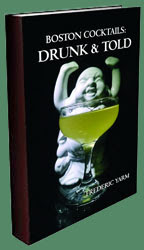Fermentation is rather helpful to people for few reasons including preservation, flavor intensification, intoxification, and ease of digestion. The microbes doing this work take complex molecules, digest them, and spit out some combination of acids, ethanol, gas (such as carbon dioxide), aromas, and flavor molecules. While these molecules can be of use to us, the microbes are secreting some of these molecules as part of their chemical warfare system against other species of microbes. For example, the alcohol that brewer's yeast produces can kill bacteria, and the acid that lactobacillus churns out can poison out competitors.
Cooking is not so far from rotting, and fermentation is rather tied to this trend. Adams showed images of Klaus Pichler's pictures of rotting food to demonstrate some of these concepts, and the photos reminded me of Peter Greenaway's A Zed & Two Noughts. However, fermentation is your friend and it's more than just rotting food. The bans on cured hams and unpasteurized cheeses have helped to confuse this matter. The sterilization of our food and our bodies has caused multiple issues such as with colds and allergies, and there has been a buzz about probiotics as of late to return our internal flora to regain the health benefits.

Adams presented the history of microbes starting 7000 BCE with the first recorded mention of China making alcohol out of rice. It took a while for microbes to be identified with 1837 and 1840s yielding the identification of yeast and bacteria, respectively, and it was not until 1856 that Louis Pasteur connected yeast to alcohol fermentation. In the United States, the health benefits were first sought after around 1910 with the importation of yogurt as a health food and digestion aid. Trends slowed down with the prohibition of fermented beverages in the 1920s, the advent of anti-bacterial deodorant soap in 1948, and the widespread use of anti-bacterial soaps in households in the 1990s.
In bread, activated amylase enzymes in wheat and the various enzymes in yeast begin to break down large starch molecules into simple sugars such as glucose, fructose, and maltose. While yeast will break the glucose and fructose down into alcohol and carbon dioxide, bacteria such as found in sour dough cultures will break down the maltose sugar in lactic and acetic acid. These bacterial acids generated in longer, slower fermented breads can yield longer shelf lives; bread becomes more interesting when left to rise overnight or for two days in the fridge. As an example, Adams passed out to the audience a quick rise, a one day, and a two day slow rise; the zero day was the sweetest, the one day was drier, and the two day had a bounty of additional pleasant flavors in the mix. As for health benefits, the microbes help to reduce some of the gluten in bread and to produce acids to inhibit molds. Additionally, during the baking process, the heat combines acids and alcohol into esters that offer the delightful freshly baked bread aroma.
In yogurt, the bacteria eats the lactose that many people have a problem digesting. Moreover, the bacteria add intriguing flavor with the lactic acid production and donate health benefits as probiotics for the digestive system. The acid in yogurt is helpful in cooking as it can be added to sweeter foods for balance. Adams showed off her home unit that maintains temperature to make a batch of 7 servings of yogurt overnight.
In fermented pickles, the naturally occurring lactobacillus on the surface of cucumbers works with brine to turn the sugars in the cucumber into lactic acid and carbon dioxide. Vinegar-processed pickles are not fermented -- the acetic acid in the vinegar itself is fermented, but not the pickles. While Adams did not cover shrubs, most of the quick hot- and cold-processed shrub recipes are not fermented either. Some slower methods of making shrubs can be partially fermented though. In pickling, the lactic acid-producing bacteria like salt and 70°F. Bad bacteria generally do not like this environment though; too much or too little salt (outside of the 3.5-5% salt solution range) or too hot or too cold will give other microbes an advantage. Pickling offers several advantages. First, it preserves fruits and vegetables; moreover, it adds flavor, increases the memory of food, and adds vitamin B to the diet.
For further information, Adams cited as her bible Sandor Ellix Katz's The Art of Fermentation. I also took photos of Adam's pickle and Rialto's bread recipes in order to share some of the details not covered here.
 The 2017 collection of 855 drink recipes, bartender tributes, and essays on hospitality from CocktailVirgin's Frederic Yarm. Available at
The 2017 collection of 855 drink recipes, bartender tributes, and essays on hospitality from CocktailVirgin's Frederic Yarm. Available at  The 2012 collection of 505 drink recipes, techniques, and Boston bar recommendations from Frederic Yarm. Available at
The 2012 collection of 505 drink recipes, techniques, and Boston bar recommendations from Frederic Yarm. Available at 




No comments:
Post a Comment